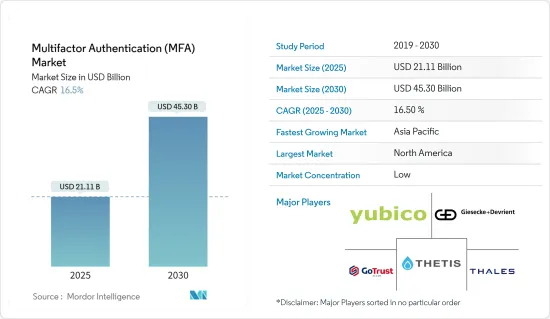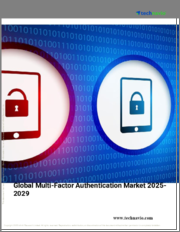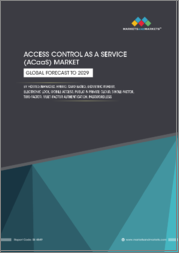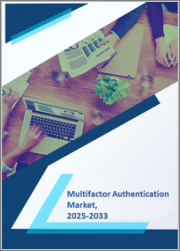
|
시장보고서
상품코드
1686598
다단계 인증(MFA) : 시장 점유율 분석, 산업 동향 및 통계, 성장 예측(2025-2030년)Multifactor Authentication (MFA) - Market Share Analysis, Industry Trends & Statistics, Growth Forecasts (2025 - 2030) |
||||||
다단계 인증(MFA) 시장 규모는 2025년에 211억 1,000만 달러로 추정되고, 2030년에는 453억 달러에 달할 것으로 예측되며, 예측기간(2025-2030년)의 CAGR은 16.5%를 나타낼 전망입니다.

피싱 공격과 데이터 유출을 비롯한 사이버 위협의 빈도와 정교함이 증가함에 따라 조직은 기밀 정보를 보호하고 무단 액세스를 방지하기 위해 다단계 인증과 같은 강력한 보안 조치를 구현해야 한다는 압박을 받고 있습니다. 일반 데이터 보호 규정, 건강보험 이동성 및 책임법, PCI 보안 표준을 비롯한 엄격한 데이터 보호 법률 및 규정 준수 표준이 MFA 도입을 촉진하고 있습니다.
다단계 인증 솔루션에 대한 수요를 촉진하려면 규정 준수가 중요합니다. 전 세계 정부 및 업계 규제 기관은 일반 데이터 보호 규정, HIPAA, PCI DSS 등 민감한 데이터를 보호하기 위해 엄격한 보안 표준을 설정하고 있습니다. 이러한 요건을 준수하기 위해 인증 보안을 강화하는 신뢰할 수 있는 수단으로 MFA에 의존하는 조직이 점점 더 많아지고 있습니다. 이러한 규정을 준수하지 않을 경우 상당한 제재와 사법적 처벌을 받을 수 있으므로 MFA 구현은 기업의 리스크 완화를 위한 핵심 단계입니다.
디지털화된 운영 프로세스를 갖추기 위한 인터넷 사용 증가에 힘입어 BFSI, 의료, IT, 통신 등 다양한 최종 사용자 산업에서 사이버 공격 사례가 증가함에 따라 시장에서 다단계 인증(MFA) 솔루션에 대한 수요가 증가하고 있습니다. MFA는 사용자의 액세스 제어, 엔드포인트 시스템 또는 회사 데이터에 보호 계층을 추가하여 비밀번호 도용, 멀웨어, 피싱 및 랜섬웨어 공격을 효과적으로 방지합니다.
MFA(다단계 인증)는 산업용 사물 인터넷(IIoT)의 보안 조치를 강화하는 데 크게 사용되고 있습니다. 생체인식, 소지, 일회용 비밀번호(OTP), 타임스탬프, 챌린지, 비밀번호 등 두 가지 이상의 인증 단계를 통합하여 IIOT 사용자, 네트워크 관리자, 유지보수 담당자의 안전한 액세스에 사용할 수 있어 전 세계 IIOT의 성장에 따라 시장에서 NFA 솔루션에 대한 수요를 주도하고 있습니다.
기술은 MFA의 구성 단계 중 하나에 불과합니다. 효과적인 데이터 보안을 위해서는 중요한 데이터를 처리 및 저장하고 보안 위반에 대처하기 위한 세부 정책과 절차를 포함한 MFA의 모범 사례가 기본적으로 필요합니다. 또한 효과적인 MFA는 데이터 보안 요구사항에 대한 IT 직원의 지식과 데이터 보안 관행에 대한 최종 사용자의 인식에 달려 있습니다.
또한 이스라엘-팔레스타인 문제로 인해 사이버 공격도 증가하고 있습니다. 예를 들어, 다양한 핵티비스트 그룹이 이스라엘과 팔레스타인의 중요 인프라, 정부 기관 및 조직을 표적으로 삼았습니다. 이러한 공격에는 디도스 공격, 명예 훼손, 데이터 유출도 포함됩니다. 다른 국가들이 전쟁에 대한 입장을 취하면서 분쟁은 인근 지역을 넘어 다른 여러 국가에 영향을 미치며 확산되고 있습니다. 따라서 지정학적 우려가 커지면서 여러 사이버 위협이 발생할 것으로 예상되며, 예측 기간 동안 사이버 보안 전략 및 솔루션을 채택하고 구현하는 데 있어 상승 추세가 나타날 것으로 보입니다.
다단계 인증(MFA) 시장 동향
크게 성장하는 이중 인증 유형
- 일반적으로 비밀번호나 OTP와 같이 사용자가 알고 있는 정보를 요구하는 인증 계층을 추가하는 2단계 인증에 대한 수요가 전 세계적으로 증가하고 있습니다. 이러한 다중 계층 접근 방식은 피싱 시도와 크리덴셜 스터핑에 대한 취약성을 크게 줄여 디지털 자산에 강력한 보안을 제공합니다.
- 또한 데이터 유출과 사이버 공격이 증가함에 따라 비밀번호에만 의존하는 것이 부적절하다는 점이 강조되고 있습니다. 한 플랫폼에서 유출된 인증정보가 여러 계정의 잠금을 해제하는 열쇠 역할을 하는 경우가 많으며, 이는 광범위한 영향을 미치는 침해 사고로 이어집니다. 이러한 이유로 대부분의 기업은 인증 프레임워크에 2단계 인증을 통합하고 있습니다. 이를 통해 조직은 비밀번호가 유출된 경우에도 무단 액세스를 차단할 수 있어 2단계 인증에 대한 수요가 증가하고 있습니다.
- 또한, 수요가 증가함에 따라 대부분의 기업은 사용자에게 더 높은 보안을 제공하기 위해 2단계 인증 시스템을 구현하기 시작하여 시장의 성장을 주도하고 있습니다. 예를 들어 2024년 4월 인도 연금기금규제개발청(PFRDA)은 보안시스템을 강화하기 위해 국민연금제도(NPS)의 현재 로그인 프로세스를 새로 고칠 예정이라고 발표했습니다. 이 기관은 2단계 Aadhaar 인증을 도입하고 NPS의 Central Recordkeeping Agency 시스템에 로그인하는 모든 암호 기반 사용자에게 새로운 보안을 의무화했습니다.
- 또한 클라우드 기반 서비스의 성장과 사물 인터넷(IoT) 디바이스의 출현으로 사이버 위협이 기하급수적으로 확대되고 있습니다. GSMA는 2023년 3월 현재 전 세계 기업의 사물인터넷(IoT) 연결이 크게 증가하고 있으며, 2030년에는 이러한 연결이 440억 개에 달해 데이터 유출 위험이 높아질 것이라고 보고했습니다. 이에 따라 클라우드 서비스 제공업체와 기업들은 서로 다른 플랫폼과 환경에서 사용자와 디바이스를 인증할 수 있는 2단계 인증을 도입하기 시작했습니다.
북미가 가장 큰 시장 점유율을 차지
- 미국은 정교하고 진화하는 사이버 위협 환경에 직면해 있습니다. 다른 국가에 비해 최종 사용자 산업에서 디지털 기술의 보급률이 높아 사이버 범죄의 진원지가 되고 있습니다. 미국의 기업들은 더 많은 양의 사이버 공격에 직면하고 있으며, 이로 인해 막대한 비용이 발생하고 있습니다. 조직과 개인이 직면하는 사이버 위협과 공격의 증가로 인해 사이버 보안은 미국에서 점점 더 중요한 초점 영역이 되었습니다.
- 또한 2024년 2월에 발표된 Identity Theft Resource Center(ITRC) 보고서에 따르면 2023년 미국에서는 3,205건의 데이터 유출이 기록되어 2022년부터 78%, 2021년에서 72% 증가했습니다. 이러한 유명한 데이터 유출 및 사이버 보안 사건은 개인 정보와 기밀 정보를 보호하기 위한 견고한 보안 조치를 시행하는 것의 중요성에 대한 기업과 소비자의 의식을 높이고 있습니다. 따라서 기업은 계정 탈취와 ID 관련 사기의 위험을 줄이기 위해 다단계 인증 솔루션의 채택을 늘리고 있습니다.
- 캐나다의 사이버 보안 시장은 민간 및 공공 부문의 디지털화 추세에 따라 진화하고 있습니다. 예를 들어 캐나다의 에너지 부문은 클라우드, AI, IoT, 양자 컴퓨팅과 같은 디지털 기술이 주도하는 변화를 목격하고 있습니다. 산업이 발전함에 따라 사이버 보안에 대한 수요도 증가하고 있습니다.
- 총 소유 비용을 최소화하기 위한 보안 솔루션의 클라우드 배포로의 전환은 다단계 인증 솔루션 제공업체에게 국내 고객 수요에 맞는 솔루션을 개발할 수 있는 기회를 제공할 것으로 예상됩니다.
다단계 인증(MFA) 시장 개요
다단계 인증 시장은 전 세계 기업과 중소기업 모두가 존재하기 때문에 단편화되었습니다. 시장의 주요 기업은 Yubico AB, Giesecke Devrient GmbH, Thetis, GoTrustid Inc., Thales 등이 있습니다. 시장 기업은 제품 라인업을 강화하고 지속 가능한 경쟁 우위를 얻기 위해 제휴 및 인수와 같은 전략을 채택합니다.
- 2024년 2월 : Giesecke Devrient는 소프트웨어 회사 Netcetera에 대한 투자 비율을 높이고 금융 플랫폼에서 디지털 포트폴리오를 강화했습니다. 이 움직임은 디지털 결제 및 뱅킹에서 Giesecke Devrient의 제안을 강화하고 금융 부문에 MFA 기반 솔루션을 도입하는 길을 열어 시장에서의 존재감을 강화하는 것을 목표로 하고 있습니다.
- 2023년 11월 : Okta Inc.는 모바일 디바이스 관리(MDM) 제공업체인 Trio와 제휴. 이 제휴를 통해 Trio는 모든 규모의 직장에서 장치 관리 및 보안을 위한 종합적인 솔루션을 제공할 수 있습니다. 이 제휴는 ID 액세스 관리 솔루션에 중점을 두고 있는 Okta의 전략에 따라 MFA 시장에서의 입지를 확대할 것입니다.
기타 혜택
- 엑셀 형식 시장 예측(ME) 시트
- 3개월간의 애널리스트 지원
목차
제1장 서론
- 조사의 전제조건과 시장 정의
- 조사 범위
제2장 조사 방법
제3장 주요 요약
제4장 시장 인사이트
- 시장 개요
- 거시 경제 시나리오 분석
- 사이버 보안 관련 규제 환경에 대한 인사이트
제5장 시장 역학
- 시장 성장 촉진요인
- 사이버 범죄, 디지털 혼란 및 규정 준수 요구 증가
- 상호 연결된 장치의 채택 증가
- 신원 도용 및 사기 사례 증가
- 시장의 과제
- 기술 전문성 부족
- 다단계 인증 구현 및 사용의 복잡성
- 시장 기회
- 인증 솔루션에 대한 표준 및 규격(ACE, FBA, FIDO 등)
- MFA 도구(하드웨어 및 소프트웨어)에 대한 가격 분석
제6장 시장 세분화
- 제공 유형별
- 하드웨어
- 토큰
- 생체 인식 장치
- 기타 디바이스
- 소프트웨어
- 인증 솔루션
- 모바일 앱
- 서비스별
- 하드웨어
- 인증 유형별
- 2단계 인증
- 3단계 인증
- 4단계 인증
- 기타 인증 유형
- 최종 사용자 업계별
- 은행 및 금융기관
- 암호화폐
- 기술 기반 기업(SaaS 및 IT 서비스 공급업체)
- 정부 : 연방, 주 및 지방 기관(시스템 통합업체 포함)
- 의료 및 제약
- 소매 및 전자상거래
- 프로세스 기반 용도 : 에너지, 제조
- 기타 최종 사용자 업계 : 교육, 이민 등
- 지역별
- 북미
- 미국
- 캐나다
- 유럽
- 영국
- 독일
- 프랑스
- 아시아
- 중국
- 인도
- 일본
- 호주 및 뉴질랜드
- 라틴아메리카
- 중동 및 아프리카
- 북미
제7장 경쟁 구도
- 벤더 포지셔닝 분석
- 기업 프로파일
- Yubico AB
- Giesecke Devrient GmbH
- Thetis
- GoTrustid Inc.
- Thales
- Duo(Cisco Systems Inc.)
- RSA SECURITY LLC
- Okta Inc.
- Google LLC(ALPHABET INC.)
- Ping Identity Corporation
- ManageEngine(조호사 Pvt. Ltd)
- Microsoft Corporation
- Telesign Corporation(Proximus Group)
제8장 시장 전망
HBR 25.04.04The Multifactor Authentication Market size is estimated at USD 21.11 billion in 2025, and is expected to reach USD 45.30 billion by 2030, at a CAGR of 16.5% during the forecast period (2025-2030).

With the increasing frequency and sophistication of cyber threats, including phishing attacks and data breaches, organizations are pressured to implement strong security measures, such as multi-factor authentication, to protect confidential information and prevent unauthorized access. Strict data protection legislation and compliance standards, including the General Data Protection Regulation, Health Insurance Portability and Accountability Act, and PCI Security Standards, are driving MFA adoption.
To drive demand for multi-factor authentication solutions, regulatory compliance is crucial. Governments and industry regulators worldwide, such as the General Data Protection Regulation, HIPAA, or PCI DSS, have set strict security standards to protect sensitive data. Organizations increasingly rely on MFA as a reliable means of enhancing authentication security to comply with these requirements. The failure to comply with these regulations may lead to significant sanctions and possible judicial consequences, making the implementation of MFA a key element in risk mitigation for companies.
The rising instances of cyber-attacks in various end-user industries, including BFSI, healthcare, IT, and telecom, supported by their increasing usage of the internet to have digitalized operational processes, are fueling the demand for multi-factor authentication (MFA) solutions in the market. MFA adds a layer of protection to the user's access control, endpoint systems, or company data, which effectively helps prevent stolen passwords, malware, phishing, and ransomware attacks.
Multi-factor authentication (MFA) has been significantly used to enhance security measures in the Industrial Internet of Things (IIoT). It helps integrate two or more authentication factors such as biometrics, possession, one-time passwords (OTP), timestamps, challenges, and passwords, which can be used for the secure access of IIOT users, network administrators, and maintenance personnel, driving the demand for NFA solution in the market in line with the growth of IIOT worldwide.
Technology is only one of the components of MFA. Effective data security primarily requires the best practices of MFA, including detailed policies and procedures for handling and storing critical data and dealing with security violations. An effective MFA also depends upon the IT staff's knowledge of data security requirements and end-user awareness of data security practices.
Furthermore, the Israel-Palestine issue has also prompted an increase in cyber attacks. For instance, various hacktivist groups have targeted critical infrastructure, government agencies, and organizations in both Israel and Palestine. DDoS attacks, defacements, and data breaches are also included in these attacks. As other countries take a stand on the war, the conflict has spread beyond the immediate region, affecting several other countries. Therefore, the growing geopolitical concerns are expected to cause several cyber threats, indicating an upward trend in adopting and implementing cybersecurity strategies and solutions during the forecast period.
Multifactor Authentication (MFA) Market Trends
Two-factor Authentication Type to Witness Major Growth
- There has been a growing demand for two-factor authentication globally as it adds a layer of authentication, typically requiring something the user knows, such as a password or an OTP. This multi-tiered approach significantly reduces the vulnerability to phishing attempts and credential stuffing, thereby providing strong security to digital assets.
- Additionally, the growing number of data breaches and cyber-attacks has underscored the inadequacy of reliance solely on passwords. The compromised credentials of one platform often serve as the keys to unlocking multiple accounts, leading to reduced breaches with far-reaching repercussions. Due to this, most companies are integrating two-factor authentication into their authentication frameworks. With this, organizations can eliminate unauthorized access even during password compromises, driving the demand for two-factor authentication.
- Furthermore, as the demand grows, most companies have started implementing two-factor authentication systems to provide more security to their users, driving the market's growth. For instance, in April 2024, the Pension Fund Regulatory and Development Authority (PFRDA) of India announced that the organization planned to revamp its current login process for the National Pension System (NPS) to enhance its security system. The organization has implemented a two-factor Aadhaar authentication and made the new security mandatory for all password-based users logging into the Central Recordkeeping Agency system of the NPS.
- Furthermore, the growing cloud-based services and the advent of Internet of Things (IoT) devices have expanded the cyber threats exponentially. As of March 2023, GSMA reported that the Internet of Things (IoT) connections across the world in enterprises are increasing significantly, and these connections would reach 44 billion by 2030, raising the risk of data breaches. Due to this, cloud service providers and enterprises have started implementing two-factor authentication, which can authenticate users and devices across disparate platforms and environments.
North America Holds the Largest Market Share
- The United States faces a sophisticated and evolving cyber threat landscape. It is at the epicenter of cybercrime due to the growing penetration of digital technologies in end-user industries compared to other countries. Businesses in the United States face a higher volume of cyber-attacks, which incur costly consequences. Cybersecurity has become an increasingly important area of focus in the country, owing to the rising number of cyber threats and attacks that organizations and individuals face.
- Additionally, as per the Identity Theft Resource Center (ITRC) report published in February 2024, in 2023, the United States recorded 3,205 data breaches, a 78% increase from 2022 and a 72% increase since 2021. Such high-profile data breaches and cybersecurity incidents have raised awareness among businesses and consumers about the importance of implementing robust security measures to safeguard personal and sensitive information. Hence, companies are increasingly adopting multi-factor authentication solutions to help organizations mitigate the risk of account takeover and identity-related fraud.
- The cybersecurity market in Canada is evolving with the increasing digitalization trends in the private and public sectors. For instance, the country's energy sector is witnessing a transformation driven by digital technologies such as cloud, AI, IoT, and quantum computing. As the industry evolves, the country's cybersecurity demand is growing.
- The shift toward cloud deployment of security solutions to minimize the total cost of ownership is anticipated to offer multi-factor authentication solution providers the opportunity to develop solutions to suit customer demands in the country.
Multifactor Authentication (MFA) Market Overview
The multi-factor authentication market is fragmented due to the presence of both global players and small and medium-sized enterprises. Some of the major players in the market are Yubico AB, Giesecke+Devrient GmbH, Thetis, GoTrustid Inc., and Thales. Players in the market are adopting strategies such as partnerships and acquisitions to enhance their product offerings and gain sustainable competitive advantage.
- February 2024 - Giesecke+Devrient bolstered its digital portfolio in financial platforms by increasing its stake in software firm Netcetera. This move aims to enhance Giesecke+Devrient's offerings in digital payments and banking, paving the way for the company to introduce MFA-based solutions to the financial sector, thereby strengthening its market presence.
- November 2023 - Okta Inc. teamed up with Trio, a mobile device management (MDM) provider. This collaboration empowers Trio to deliver a holistic solution for device management and security across workplaces of all sizes. This partnership is poised to amplify Okta's footprint in the MFA market, aligning with its strategic emphasis on identity access management solutions.
Additional Benefits:
- The market estimate (ME) sheet in Excel format
- 3 months of analyst support
TABLE OF CONTENTS
1 INTRODUCTION
- 1.1 Study Assumptions and Market Definition
- 1.2 Scope of the Study
2 RESEARCH METHODOLOGY
3 EXECUTIVE SUMMARY
4 MARKET INSIGHTS
- 4.1 Market Overview
- 4.2 Analysis of Macro Economic Scenarios
- 4.3 Insights on the Regulatory Landscape Related to Cyber Security
5 MARKET DYNAMICS
- 5.1 Market Drivers
- 5.1.1 Rising Cybercrime, Digital Disruption, and Increased Compliance Demands
- 5.1.2 Rising Adoption of Interconnected Devices
- 5.1.3 Increased Instances of Identity Theft and Fraud
- 5.2 Market Challenges
- 5.2.1 Lack of Technical Expertise
- 5.2.2 Complexities in Implementing and Using Multi-factor Authentication
- 5.3 Market Opportunities
- 5.3.1 Standards/Specifications for Authentication Solutions (ACE, FBA, FIDO, etc.)
- 5.3.2 Pricing Analysis for MFA Tools (Hardware and Software)
6 MARKET SEGMENTATION
- 6.1 By Offering Type
- 6.1.1 Hardware
- 6.1.1.1 Token
- 6.1.1.2 Biometric Devices
- 6.1.1.3 Other Devices
- 6.1.2 Software
- 6.1.2.1 Authenticator Solutions
- 6.1.2.2 Mobile Apps
- 6.1.3 Services
- 6.1.1 Hardware
- 6.2 By Authentication Type
- 6.2.1 Two-factor Authentication
- 6.2.2 Three-factor Authentication
- 6.2.3 Four-factor Authentication
- 6.2.4 Other Types of Authentication
- 6.3 By End-user Industry
- 6.3.1 Banking and Financial Institutions
- 6.3.2 Cryptocurrency
- 6.3.3 Technology-based Companies (SaaS and IT Service Vendors)
- 6.3.4 Government - Federal, State, and Local Entities (Including System Integrators)
- 6.3.5 Healthcare and Pharmaceutical
- 6.3.6 Retail and E-commerce
- 6.3.7 Process-based Applications - Energy and Manufacturing
- 6.3.8 Other End-user Verticals - Education, Immigration, Etc.
- 6.4 By Geography
- 6.4.1 North America
- 6.4.1.1 United States
- 6.4.1.2 Canada
- 6.4.2 Europe
- 6.4.2.1 United Kingdom
- 6.4.2.2 Germany
- 6.4.2.3 France
- 6.4.3 Asia
- 6.4.3.1 China
- 6.4.3.2 India
- 6.4.3.3 Japan
- 6.4.4 Australia and New Zealand
- 6.4.5 Latin America
- 6.4.6 Middle East and Africa
- 6.4.1 North America
7 COMPETITIVE LANDSCAPE
- 7.1 Vendor Positioning Analysis
- 7.2 Company Profiles
- 7.2.1 Yubico AB
- 7.2.2 Giesecke+Devrient GmbH
- 7.2.3 Thetis
- 7.2.4 GoTrustid Inc.
- 7.2.5 Thales
- 7.2.6 Duo (Cisco Systems Inc.)
- 7.2.7 RSA SECURITY LLC
- 7.2.8 Okta Inc.
- 7.2.9 Google LLC (ALPHABET INC.)
- 7.2.10 Ping Identity Corporation
- 7.2.11 ManageEngine (Zoho Corporation Pvt. Ltd)
- 7.2.12 Microsoft Corporation
- 7.2.13 Telesign Corporation (Proximus Group)



















